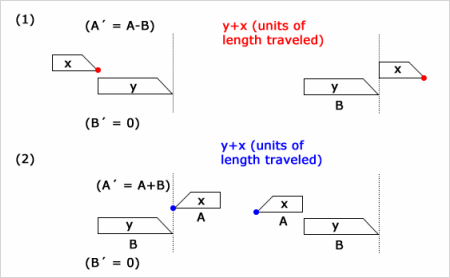GMATH practice exercise (Quant Class 19)
Two trains travel at constant speeds. What is the ratio of the slower speed to the faster speed?
(1) The time it takes for one train to pass the other when they are in the same direction is 3h.
(2) The time it takes for one train to pass the other when they are in opposite directions is 2h.
Answer: [spoiler]______(C)__[/spoiler]
Two trains travel at constant speeds. What is the ratio of t
This topic has expert replies
- fskilnik@GMATH
- GMAT Instructor
- Posts: 1449
- Joined: Sat Oct 09, 2010 2:16 pm
- Thanked: 59 times
- Followed by:33 members
Timer
00:00
Your Answer
A
B
C
D
E
Global Stats
Fabio Skilnik :: GMATH method creator ( Math for the GMAT)
English-speakers :: https://www.gmath.net
Portuguese-speakers :: https://www.gmath.com.br
English-speakers :: https://www.gmath.net
Portuguese-speakers :: https://www.gmath.com.br
- fskilnik@GMATH
- GMAT Instructor
- Posts: 1449
- Joined: Sat Oct 09, 2010 2:16 pm
- Thanked: 59 times
- Followed by:33 members
Timer
00:00
Your Answer
A
B
C
D
E
Global Stats
$${\rm{faster}}\,\,{\rm{train}}\,\,\left\{ \matrix{fskilnik@GMATH wrote:GMATH practice exercise (Quant Class 19)
Two trains travel at constant speeds. What is the ratio of the slower speed to the faster speed?
(1) The time it takes for one train to pass the other when they are in the same direction is 3h.
(2) The time it takes for one train to pass the other when they are in opposite directions is 2h.
\,x\,\,{\rm{m}}\,\,\left( {{\rm{length}}\,{\rm{:}}\,\,{\rm{meters}}} \right) \hfill \cr
\,A\,{\rm{mph}}\,\,\,\left( {{\rm{speed}}\,{\rm{:}}\,\,{\rm{meters}}\,\,{\rm{per}}\,\,{\rm{hour}}} \right) \hfill \cr} \right.$$
$${\rm{slower}}\,\,{\rm{train}}\,\,\left\{ \matrix{
\,y\,\,{\rm{m}}\,\,\left( {{\rm{length}}\,{\rm{:}}\,\,{\rm{meters}}} \right) \hfill \cr
\,B\,{\rm{mph}}\,\,\,\left( {{\rm{speed}}\,{\rm{:}}\,\,{\rm{meters}}\,\,{\rm{per}}\,\,{\rm{hour}}} \right) \hfill \cr} \right.$$
$$? = {B \over A}\,\,\,\,\,\,\,\left[ {A > B > 0} \right]$$

$$\left. \matrix{
\left( 1 \right)\,\,A - B = {{y + x} \over 3}\,\,\,\,\, \Rightarrow \,\,\,\,\,{\rm{trivial}}\,\,{\rm{bifurcation}}\,\, \hfill \cr
\left( 2 \right)\,\,A + B = {{y + x} \over 2}\,\,\,\,\, \Rightarrow \,\,\,\,\,{\rm{trivial}}\,\,{\rm{bifurcation}} \hfill \cr} \right\}\,\,\,\,\,\mathop \Rightarrow \limits^{\left( {1 + 2} \right)} \,\,\,\,3\left( {A - B} \right) = 2\left( {A + B} \right)\,\,\,\,\, \Rightarrow \,\,\,\,\,A = 5B\,\,\,\,\, \Rightarrow \,\,\,\,\,{\rm{SUFF}}.$$
The correct answer is (C).
We follow the notations and rationale taught in the GMATH method.
Regards,
Fabio.
Fabio Skilnik :: GMATH method creator ( Math for the GMAT)
English-speakers :: https://www.gmath.net
Portuguese-speakers :: https://www.gmath.com.br
English-speakers :: https://www.gmath.net
Portuguese-speakers :: https://www.gmath.com.br



















